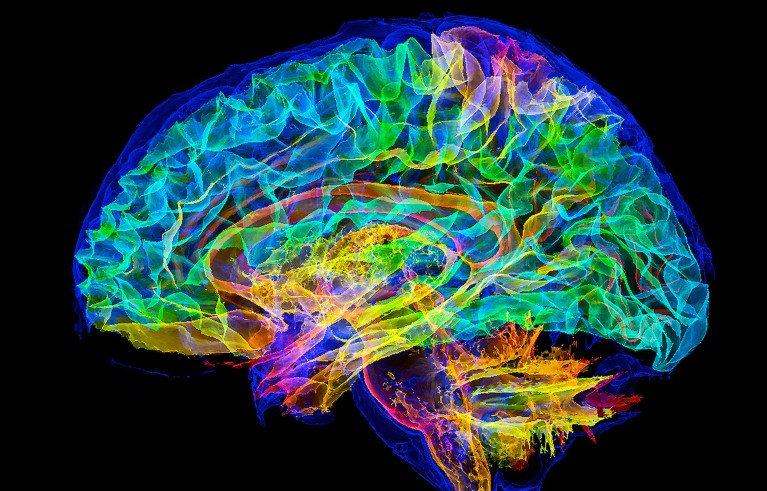
Credit: K H Fung/Science Photo Library
Since a schizophrenia drug, the first in decades with an innovative mechanism of action, gained US regulatory approval in September, some researchers have proclaimed a new era for psychiatric medicine. About half a dozen similar drugs — for schizophrenia, Alzheimer’s disease and other conditions involving the brain — are in various stages of development, most in early-stage clinical trials. But the success of these medicines is not a given. Last week, a trial of a highly anticipated schizophrenia drug reported disappointing results.
For decades, schizophrenia drugs worked in essentially the same way. They blunted the activity of dopamine, a chemical involved in the disorder’s hallmark symptoms, such as hallucinations and delusions. The new kid on the block is KarXT, sold as Cobenfy. It targets muscarinic receptors and leads to antipsychotic and cognitive benefits. “I don’t think I’ve ever seen this much buzz and excitement over a new approach in psychiatry in my career,” says Jeffrey Conn, a pharmacologist at Vanderbilt University in Nashville, Tennessee who was one of the company’s scientific co-founders.
KarXT’s success in winning US regulatory approval has revived interest in muscarinic drugs. “Drug discovery is coming back to psychiatry,” says Arthur Christopoulos, a molecular pharmacologist at Monash University in Melbourne, Australia, who was involved in the development of KarXT.
But developing new medicines is a hard, long road. On 11 November, Abbvie, a pharmaceutical company in North Chicago, Illinois, announced that its muscarinic drug for schizophrenia, called emraclidine, had failed to outperform a placebo. What this means for other muscarinic drugs in development remains to be seen, Christopoulos says. “It is still early days.”
New psychiatric drugs
KarXT’s road to development wasn’t smooth, either. Xanomeline, one of the active components of the drug, was developed in the 1990s and shown to reduce psychotic symptoms in people with Alzheimer’s disease. But, in a clinical trial1, many participants who received the drug stopped taking it owing to nausea, vomiting and other side effects. Muscarinic receptors are present throughout the brain and body so drugs that target them can have broad effects. The drug was shelved, along with others under development at the time. “Everyone, including myself and my colleagues, decided that muscarinic agonists were probably an impossible feat to accomplish,” says Conn.
In 2009, Karuna Therapeutics, based in Boston, Massachusetts, combined xanomeline with another compound, trospium, which blocks muscarinic receptors but cannot cross into the brain, preventing unwanted side effects in the body. The combination became known as KarXT. In clinical trials, people with schizophrenia taking the combined drug experienced antipsychotic and cognitive benefits, with milder side effects than for xanomeline on its own.
Mode of action
Xanomeline acts mostly on two of the five muscarinic receptors: the M1 and M4 receptors. Animal studies suggest that the M4 receptor is most strongly associated with antipsychotic effects, whereas the M1 receptor is linked to cognition.
Many of the schizophrenia drugs under investigation are aimed at just one of those receptors — a strategy that researchers hope will lead to bigger benefits with fewer side effects, says Andrew Tobin, a neuroscientist at the University of Glasgow, UK. (Tobin is the co-founder and chief executive of Keltic Pharma Therapeutics, a Dublin-based company that is working on developing muscarinic drugs.)
Because of the similarities in the binding site of all five muscarinic receptors, selectively targeting one type is a challenge, Tobin says. To get around this, researchers are investigating ‘allosteric modulators’ of muscarinic receptors, which act on their targets through regions outside the binding site that are more distinct than the sites of the five muscarinic receptors.
Emraclidine, an allosteric modulator targeting the M4 receptor, was one of the muscarinic drugs furthest along the development pipeline. But its failure in the Abbvie phase II trial raises questions, such as whether drugs need to target both the M1 and M4 receptors as KarXT does, says Brian Dean, a biochemist at The Florey Institute of Neuroscience and Mental Health in Parkville, Australia.
Alzheimer’s, addiction and beyond
Pharmaceutical giant Bristol Meyers Squibb (BMS), based in New York, which acquired Karuna in March, is running a trial in people to test whether KarXT can also help to treat psychosis associated with Alzheimer’s disease, as well as investigating whether the drug might benefit people with bipolar disorder.
Given the role of M1 receptors in cognition, researchers are also designing drugs that target that receptor to reduce cognitive decline in people with Alzheimer’s disease. Tobin says researchers are hopeful that muscarinic drugs might also slow its progression. In 2016, he and his colleagues reported that an M1-specific drug slowed neurodegeneration in mice with a disease resembling Alzheimer’s in humans2.
Muscarinic receptors are found in the reward circuits in the brain, and studies have shown that blocking these pathways can protect animals from becoming addicted to opioids. The receptors are also involved in movement, leading some scientists to also examine whether blocking them might help people with Parkinson’s disease3.
Real-world test
Although excitement swirls around KarXT, how it fares in the real world remains to be seen. During the clinical trials, participants remained in hospital, where there were few opportunities for environmental influences to affect treatment, says Carol Tamminga, a psychiatrist and neuroscientist at UT Southwestern Medical Center in Dallas, Texas. (Tamminga is a scientific adviser for Karuna and was involved in the clinical trials of KarXT).
Last month, BMS released data from two, year-long follow-up studies on KarXT treatment in people with schizophrenia who were treated as outpatients. Although they continued to improve over that time, 11–18% of the participants stopped taking the drug because of side effects. Ceasing to take a drug is a problem with other available schizophrenia therapeutics. “We’ve got a lot to learn about these drugs,” Tamminga says.


